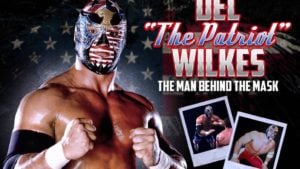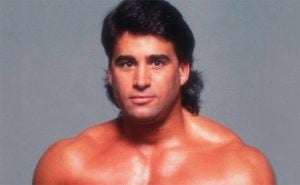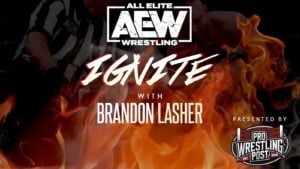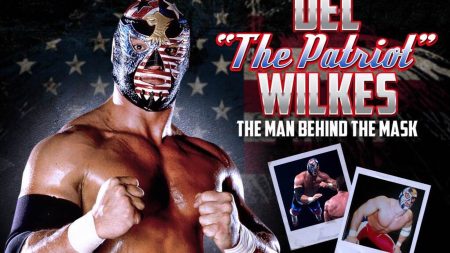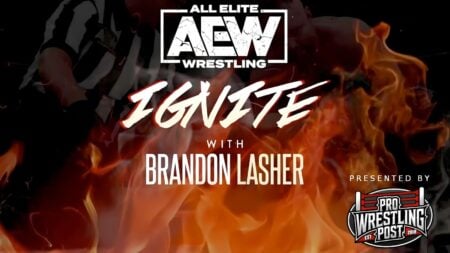As we’ve discussed before, there are certain cultures that are highly tied to the history of professional wrestling. One of those cultures is one that we’ve discussed at length. Polynesians and professional wrestling go hand-in-hand. This is the story of the life and career surrounding one of the most intimidating men in professional wrestling, Haku. It’s time to discuss the nose-biting Tongan warrior Haku also known as Meng.

Haku – The Genesis of a Sumo
Tonga ‘Uli’uli Fifita was born on February 10, 1959, in Nuku’alofa, Kingdom of Tonga. Not much is known about Fifita’s birth or upbringing. However, it is known that he was quickly drawn to the artistry of sumo wrestling and rugby. At the age of 15 years old, alongside five other teenagers, Fifita was sent to Japan by the King of Tonga to study sumo wrestling.
In 1974, Fifita would move to Japan, where he would begin training in sumo. He made his debut that November and would reach Makushita rank (the third-highest level in sumo.) Tonga would eventually be forced into retirement from the sport after he and his five other Tongan teenagers entered into a dispute with their stablemaster. The Japan Sumo Association forced them to retire in 1976. Tonga would retire with a 48-25-4 record.
Unleashing The Tongan Warrior
National Wrestling Alliance
In 1978, Tonga met with wrestlers Genichiro Tenryu and Takashi Ishikawa, who convinced him to give professional wrestling a try. Fifita would train under Giant Baba in Tenryu and Ishikawa’s home promotion of All Japan Pro Wrestling. Tonga’s earliest match on record took place for Central States Wrestling in St. Joseph, Missouri.
Fifita would undergo the persona of “Tonga Fifty.” In this match, he would contend against Benny Ramirez in a seven-minute losing effort. Five months after his debut match, Tonga would undergo a name change. On June 2, 1978, Tonga would transition into the “Prince Tonga” character. However, a name change would not lead to a victory, as he would fall to NWA: Western States’ Rip Hawk.
In September 1979, Tonga would win the NWA World Six-Man Tag Team Championship alongside Ken Lucas and George Gulas. The trio would vacate the titles the next month after Tonga would move on to a different NWA territory.
That January, Prince Tonga would transition to wrestling under the “Tama Tonga” moniker. (Interestingly enough, this is the same name that Fifita’s son would wrestle under.) Under this moniker, Tonga would win the NWA Hawaii Heavyweight Championship. However, Tonga would drop this title in July when he would make his return to mainland Japan.
All Japan Pro Wrestling
In 1980, Tonga would return to Japan to make his official All Japan Pro Wrestling debut. On July 11, 1980, on the first day of AJPW’s Summer Action Series, the renamed Prince Tonga would defeat Rick Davidson in 11 minutes. Tonga would wrestle a litany of matches in AJPW but wouldn’t amount to much in the organization.
Prince Tonga would wrestle his final AJPW match on June 10, 1982. At AJPW’s Excite Series 1982, Stan Hansen would defeat Prince Tonga in 4:08. While Tonga may not have gotten much out of his stay in All Japan Pro Wrestling, this trip abroad gave him the opportunity to refine his skills and hone them further in the United States.
A Return to the National Wrestling Alliance
On June 30, 1982, Tonga would return to the states and compete in Championship Wrestling from Florida. Tonga would debut under the name King Kong Tonga. His first match against Deke Rivers would end in a draw. Tonga would go on to switch back and forth between competing as King Kong Tonga and King Tonga.
Surprisingly, Tonga would compete for the WWF Heavyweight Championship while wrestling in Championship Wrestling from Florida. On September 26, 1982, Bob Backlund would defend the WWF Championship against King Kong Tonga. Tonga would lose this match-up, as well as the subsequent rematch two days later. In December of that year, Tonga would wrestle his last NWA: CWF match in a losing effort against Mike Graham.
A Trip To Puerto Rico
After leaving the Florida territory, Tonga would make his way down to San Juan, Puerto Rico. In his first-ever match in Puerto Rico, on January 15, 1983, King Tonga would defeat Invader #1 to win the WWC Puerto Rico Heavyweight Championship.
Tonga would defend the championship against Invader #1 and Dory Funk Jr., among many other contenders. However, on October 23, 1983, King Tonga would drop the WWC Puerto Rico Heavyweight Championship to Bob Sweetan, ending a 281-day reign.
This loss would lead to an eventual partnership between King Tonga and Hercules Ayala. Tonga and Hercules would seek tag team gold in Capitol Sports Promotions. On January 6, 1984, Hercules Ayala & King Tonga would defeat The Medics (Medic #1 & Medic #2) for the WWC World Tag Team Championship.
However, this title reign would be short-lived as The Medics would hit the gym and return 22 days later as The Super Medicos. On this day, Hercules Ayala and King Tonga would drop the WWC World Tag Team Championships back to our medical compadres.
After their brief stint with the WWC World Tag Team Championships, Tonga and Ayala would split up their tag team but keep a healthy level of camaraderie. With Ayala out of the picture, Tonga would go on to reclaim the WWC Puerto Rico Heavyweight Championship from the man who took it from him, Bob Sweetan.
Tonga would hold this title for 49 days, dropping it to rival Terry Gibbs on May 12, 1984. Seemingly, Tonga had discovered his formula for championship contention. Once he loses a singles championship, he suddenly discovers an interest in tag team competition.
A Working Relationship
After his championship lost to Terry Gibbs, Tonga would establish a relationship with wrestler Gran Apollo. This relationship would eventually lead to a tag team partnership. On June 11, 1984, King Tonga and Gran Apollo would defeat Buddy Landell and [Tonga’s] former rival Terry Gibbs for the WWC North American Tag Team Championship.
Within this time, Tonga would travel back to Japan to compete in the AJPW Grand Champion Carnival, leaving the WWC North American Tag Team Championships without a second holder. Less than a month after winning the titles, Tonga and Apollo would lose the belts to The Medics in Aguadilla, Puerto Rico. This would lead to an eventual feud spanning the course of four months.
Tonga would begin wrestling events for International Wrestling in Quebec, Canada, in the midst of this feud. On June 23, 1984, King Tonga would debut for International Wrestling with a victory over Reggie Rapone. After meeting and working with wrestling legend Tarzan Tyler, Tonga would take on Tyler as his manager.
Tonga would travel back and forth between Puerto Rico and Canada to continue his various feuds across various promotions. On October 8, 1984, King Tonga and Gran Apollo would defeat The Medics to reclaim their WWC North American Tag Team Championships. Somehow, within 24 hours of winning the WWC North American Tag Team titles, Tonga would fly to Quebec and defeat Dino Bravo for the International Wrestling Heavyweight Championship. (Tonga Two-Belts!)
As a double champion, Tonga would continue to pull double-duty for Canadian and Puerto Rican promotions. However, a new promotion would soon find interest in the Tongan Warrior. At the tail-end of 1984, the World Wrestling Federation would contact Tonga about an opportunity with the company. On January 4, 1985, King Tonga would compete in his first WWF house show, gaining a victory over “Cowboy” Bob Orton.
Working The Territories
As Tonga gained popularity within the wrestling sphere, more and more promotions would attempt to bring him. Seemingly, Tonga just couldn’t say no. However, as these offers were gearing up, his championship reigns would come to an end. On February 11, 1985, Dino Bravo would reclaim the International Wrestling Heavyweight Championship from King Tonga.
Less than two months later, Tonga and Apollo would vacate the WWC North American Tag Team Championships due to Apollo’s retirement. Admittedly, that is a valid reason for vacating a championship.
After losing his dual champion status, Tonga would continue competing for International Wrestling in Canada and begin competing for the American Wrestling Association. Tonga would debut for AWA on February 2, 1985, where he and The Masked Superstar would wrestle Greg Gagne and Jerry Blackwell to a no contest. King Tonga would compete for the AWA World Heavyweight Championship on multiple occasions but could never get the job done.
Gaining that itch for championship gold once more, Tonga would team up alongside wrestler Richard Charland and enter a tournament for the then-vacated International Wrestling Tag Team Championships.
In a shocking moment, on March 27, 1985, King Tonga and Richard Charland would defeat Jos LeDuc and Leo Burke to become the new International Wrestling Tag team Championships. Much like his other tag team championship reigns, Tonga’s time with the title would be short. 15 days after winning the titles, Tonga and Charland would drop the belts to Jacques Rougeau and Raymond Rougeau.
Havoc for Haku
World Wrestling Federation
On August 20, 1985, King Tonga would return to the World Wrestling Federation after International Wrestling, and WWF would establish a relationship. Tonga’s first match back (and his first match on television) would end in a three-minute victory over Gino Carabello.
Tonga would go on to gain victories over wrestlers Iron Mike Sharpe, Tiger Chung Lee, Barry O, Moondog Spot, and Mr. X. In late 1985, Tonga would begin a tag team with former rival Dino Bravo – and the pairing would eventually contend for the WWF World Tag Team Championships (although, they would come up short.)
In 1986, King Tonga would make a name for himself beyond his quick and dominating victories on the house show circuit. On WWF Championship Wrestling, King Tonga would become the first wrestler to bodyslam Big John Studd when he answered Bobby Heenan’s $15,000 Bodyslam Challenge.
However, Heenan wouldn’t end up paying Tonga for his achievement. Later that year, Tonga would end up forming a tag team with real-life relative Tonga Kid. This pairing would debut on September 15, 1986’s WWF Superstars of Wrestling, where he, Tonga Kid, and Pedro Morales would defeat Ken Glover and The Hart Foundation in 1:26.
In October 1986, Tonga would undergo another name change where he would adopt a pseudonym that would go on to define him. On October 3, 1986, Tonga (now known as Haku) and Tonga Kid (now known as Tama) would defeat Bob Orton and Steve Lombardi.
The Islanders would not amount to much in WWF; however, they did go on to with the 1986 $50,000 MSG Tag Team Battle Royal. The pairing would turn heel in 1987 after aligning themselves with manager Bobby Heenan.
Tag Team Aspirations
After aligning with Bobby Heenan, The Islanders would go on to feud with The Can-Am Connection (Rick Martel and Tom Zenk.) Eventually, Zenk would leave the WWF, but this feud would be far from over.
Martel would recruit the help of Tito Santana, and the tandem would form a team dubbed Strike Force to continue the war. For months, The Islanders would challenge Strike Force for their WWF World Tag Team Championships. However, this would not work out in their favor.
In the build-up to WrestleMania IV, The Islanders would engage in a rivalry with The British Bulldogs (Davey Boy Smith and Dynamite Kid.) This feud would ignite after The Islanders (alongside Bobby Heenan) would kidnap The British Bulldogs’ mascot, Matilda The Bulldog.
After the duos traded wins and losses, the feud would be capped off in a six-man tag team match at WrestleMania IV. On March 27, 1988, WrestleMania IV, Bobby Heenan and The Islanders would defeat Koko B. Ware and The British Bulldogs in 7:30.

Crowning King Haku
After WrestleMania IV, Haku would start to follow more of a singles contender trail. After King Harley Race suffered an injury during a match against Hulk Hogan, WWF would decide to pass the “king” gimmick on to the Tongan Warrior. Thus, King Haku was born!
On June 21, 1988, King Haku would debut with a victory over Jerry Allen on WWF Superstars. As King, Haku would begin receiving a multitude of WWF World Heavyweight Championship opportunities against Randy Savage (which he would come up short in.)
At the turn of 1989, Haku would engage in a feud with Harley Race, the former King of the Ring. At the 1989 Royal Rumble, Harley Race would contend for his crown and scepter in a match against King Haku but would come up short against the Tongan Warrior.
Three months later, Haku would engage in a rivalry with “Hacksaw” Jim Duggan, where he would lose the title of “King” to the New York native. On May 12, 1989, the Tongan wrestler would return to competition with the shortened name “Haku.”
“I Got Your Nose”
The following story is considered one of the most brutal stories to come out of professional wrestling. On March 3, 1989, it is alleged that Haku was involved in an altercation with men at a Baltimore Airport who referred to wrestling as fake.
While we’ve seen the damage wrestlers can cause at the mention of wrestling being “fake” (see David Schultz, Vader, The Undertaker, etc.), none of them went as poorly as this allegedly did. It is reported that in the altercation, Haku bit off the nose of one of the men. This has only added to the legendary mystique of Haku as a wrestler and as a man.
The Colossal Connection
In late 1989, Bobby Heenan would pair two of the most intimidating members of his managerial family together for competition. Thus, we introduce The Colossal Connection – Haku and Andre The Giant. Originally, the tandem would wrestle under the name “The Heenan Family.” In November, they would officially dawn this new name. One month later, The Colossal Connection would defeat Demolition to win the WWF World Tag Team Champions.
The Colossal Connection would feud with Demolition for the next four months, leading to a match at WrestleMania VI. At WrestleMania VI, Demolition would defeat The Colossal Connection to reclaim the WWF World Tag Team Championships. In this 9 minute match, Haku wouldn’t even tag in Andre, as Andre’s health was slowly deteriorating. Minus a couple of house show appearances, this would effectively be the end of Andre and Haku’s connection.
Meandering In The Mid-Card
After WrestleMania, Haku would not amount to much else within the company. Haku would have a slew of matches against the WWF Champion, Ultimate Warrior, but would lose those encounters. He would also wrestle the house show circuit against WWF Intercontinental Champion, The Texas Tornado, but nothing would come of this either.
In 1991, Haku would form a tag team with his childhood friend The Barbarian. The only notable moment for this tandem would come in the form of a loss in the opening contest of WrestleMania VII against The Rockers.
Going into 1992, Haku would wrestle under his “King Haku” moniker at Super World of Sports as part of their partnership with WWF. Haku would partner with SWS’s Yoshiaki Yatsu and enter a tournament for the then-vacated SWS Tag Team Championships. Haku and Yatsu would wrestle up until the finals of the tournament. On February 14, 1992, King Haku and Yoshiaki Yatsu would defeat Ashura Hara and Genichiro Tenryu to become the new SWS Tag Team Champions.
Haku and Yatsu would defend the titles against the likes of George Takano, Shunji Takano, and Genichiro Tenryu. Two months after their victory, though, George Takano and Shunji Takano would defeat Haku and Yatsu to win the SWS Tag Team Championships. Shortly after competing in the 1992 Royal Rumble match, Haku would be released from his WWF contract to compete for Super World of Sports full-time.
Doing It On Your Own
Various Territories
After being released from his WWF contract, Haku would continue to compete under the “King Haku” moniker. He and Yoshiaki Yatsu would go on to pick up the SWS Tag Team Championships a second time after defeating Earthquake and Typhoon at SWS’s The Battle of Kings 1992.
Haku and Yoshiaki Yatsu would hold the titles for two more months, dropping them when SWS closed down later that year. On June 19, 1992, Haku would wrestle his final SWS match. At SWS Declaration of War ’92, Ashura Hara, Genichiro Tenryu, & Ultimo Dragon would defeat Jerry Estrada, King Haku, & The Great Kabuki in 18 minutes.
Consejo Mundial de Lucha Libre
SWS would close down, and King Haku would move on. Haku would eventually sign with Mexican promotion CMLL and would make his first appearance on June 26, 1992. On CMLL TV, El Rayo del Jalisco Jr., King Haku, & Vampiro Canadense would defeat Emilio Charles Jr., Pierroth Jr., & Sangre Chicana in a two-out-of-three falls match.
During his stint in Mexico, Haku would also wrestle for the Japanese WAR promotion. He would defeat Kerry Von Erich in his debut match in WAR. Haku would bounce back and forth between WAR and CMLL before being signed to World Championship Wrestling in 1994. Haku’s final match in CMLL would take place on June 3, 1994, where King Haku, Silver King, & El Dandy would defeat La Ola Blanca.
World Championship Wrestling
Later in the year, Haku would debut on WCW television as “Meng.” Meng would originally debut as a bodyguard for Col. Robert Parker. However, at SuperBrawl V, Meng would attack Jim Duggan. Inevitably, the week afterward, Col. Robert Parker would announce that Meng would be released from his bodyguard duties.
Instead, he would become an active in-ring competitor. That night, February 2, 1995, Meng would defeat Al Phillips in less than one minute. Following his debut, Meng would go on a winning streak. At Uncensored 1995, Meng would defeat Jim Duggan in a Martial Arts Match (refereed by manager Sonny Onoo.) He would suffer his first loss at The Great American Bash 1995 in a match against Sting with the WCW United States Championship on the line.
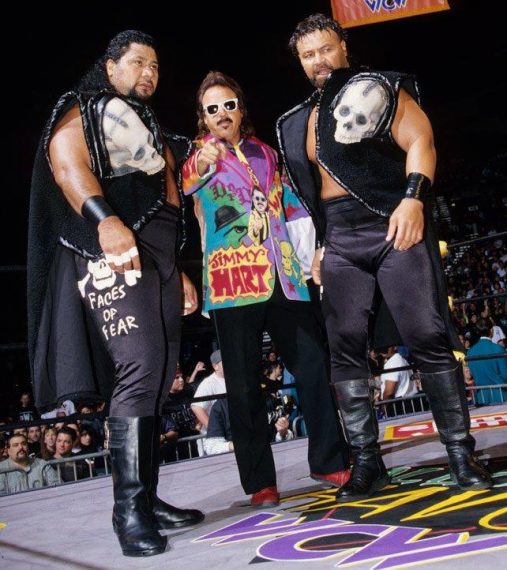
After taking his first loss to Sting, Meng would partner with Japanese wrestler Kurasawa to feud with Sting and Road Warrior Hawk. They would come out on the shorter side of this feud. Post-feud with Sting, Meng would join one of the most controversial groups of mid-90’s WCW – The Dungeon of Doom.
Meng would be repackaged as “The Face of Terror” and would form a tag team alongside his form WWF tag partner, The Barbarian. This tag-team would be known as The Faces of Fear. Terror wouldn’t do much in WCW past this point, other than taking losses to up-and-coming tag teams like Harlem Heat and The Outsiders.
In 1996, our favorite Tongan Monster would adopt the name “Meng” once more. He would wrestle mid-card and lower-card performers, picking up meaningless wins and losses on television. In 1999, Meng would become close with WCW President Ric Flair. In fact, Meng would do Flair’s bidding and attack anyone who Flair wanted to inflict pain upon. However, this quickly fizzled out.
Independent Contractor
Meng would contend for the newly unveiled WCW Hardcore Championship in very lackluster contests throughout the next two years. Possibly realizing that the writing was on the wall for WCW, Meng would begin to wrestle on the independent circuit while under contract with WCW.
In March 2000, Meng would debut in World League Wrestling. He would compete against Mr. Destiny for the WLW Heavyweight Championship but would lose via disqualification. Meng would continue to vie for the WLW Heavyweight title for weeks before finally claiming it one month later from The Luminous Warrior. The Tongan Monster would immediately lose the title to Trevor Rhodes (the future Trevor Murdoch) two days later.
On October 20, 2000, Meng would regain the WLW Heavyweight Championship in a Three-Way Match against Griz and Mr. Destiny (with Harley Race serving as special guest referee.) Meng would drop the championship one day later after losing to Griz.
Three months later, Meng would win the WCW Hardcore Championship in a three-way dance at WCW Sin 2001. He would pin Crowbar and Terry Funk to win the championship and would end up being the final champion before WWE purchased the company that year.
Haku – Returning to the Federation
At Royal Rumble 2001, Meng would return to the WWF as “Haku.” Haku would enter the Royal Rumble match but would not win. After the Royal Rumble, Haku would establish a partnership with Rikishi.
However, Rikishi would soon become injured, nixing those plans. Haku would drop to lower-card status, going on to wrestling his final WWF match on July 23, 2001. In this match, Haku would take the fall to Shawn Stasiak in less than three minutes. Haku would wrestle his final WWF-sanctioned match on an Asian house show tour where he would lose multiple WWF European Championship matches to Diamond Dallas Page.
Winding Down His Career
Working The Independents
On April 19, 2002, Haku would return to World League Wrestling to contend for the WLW Heavyweight Championship (however, he would lose by DQ.) Over the course of the next year and a half, Haku would compete for the WLW Heavyweight Championship multiple times a month.
Finally, on February 8, 2003, Haku would defeat WLW Heavyweight Champion, Superstar Steve, to win the title. The Monster would defend his prize against Bull Schmitt but would drop it to Trevor Rhodes after a little over a month of holding it. Haku would wrestle his last WLW match in a losing effort against Trevor Rhodes and Ace Steel in 2005.
Haku’s wrestling appearances began to become more sporadic as time moved on. He would only wrestle a handful of matches more after his WLW stint. Across 2009, Haku would win the World Xtreme Wrestling Hardcore Championship (however, there isn’t much known about his WXW run.) Haku’s last match to date took place at ICW No Holds Barred, Vol. 8. On November 14, 2020, Meng would wrestle SHLAK to a 10:30 no contest.
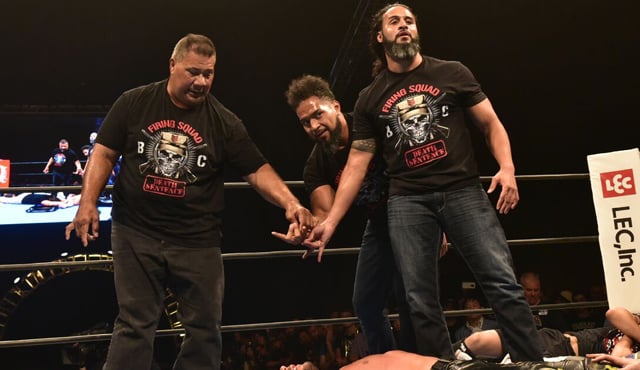
Haku would make some final appearances in New Japan Pro Wrestling to support his sons Tama Tonga and Tonga Loa within their wrestling journeys. Alongside his sons, he would also take part in the infamous Bullet Club split after Kenny Omega’s IWGP Heavyweight Championship victory. Haku would also wrestle a couple of matches alongside his sons, but not much would come out of this. The jury is still out on if Haku will ever step back in the ring again, but never say never.
Leaving A Legacy
In an interview with Bobby Heenan, Haku was once referred to as “the toughest man he has ever met.” Heenan shared a story of Haku’s, which involved him taking “his two fingers on his right hand, his index finger and trigger finger, and he reached into the guy’s mouth, and he broke off the guy’s bottom teeth.” Heenan also claimed that Andre the Giant was only afraid of two men in the world – Harley Race and Haku.
If you are entering professional wrestling, you are entering an industry built on toughness and projected legitimacy. Haku is a man who has never had to prove his toughness. Haku’s legend has been built off of immaculate stories of toughness both inside the ring and outside of the ring.
However, Haku is widely regarded as one of the sweetest individuals in professional wrestling. The Tongan Warrior is recognized as a loving father and family-centered individual. True legitimacy and human kindness are two areas most lacking in professional wrestling – and Haku embodied both of those characteristics.
Overall, Haku’s career is one of modesty. Haku was never a world champion in a major company, but he didn’t need to be. Backstage, Tonga Fifita is a great man who has built a great career off of his hard work and dedication to the craft.
Meng/Haku is one of the most frightening workhorses you could ever meet in the squared circle in the ring. Haku didn’t need to be 7’0″ tall or 400 pounds to instill fear in his opponents. His sheer brutality and aura were enough to make any performer wet the bed; that is the mark of a great professional wrestler. It’s for this reason that we celebrate Haku’s life and career during AAPI Heritage Month.
Haku – The Most Intimidating Man In The Business
Sources:
- “Haku.” Cagematch,
- “Pro-Wrestling Title Histories.”
- Sharnoff, Lora. Grand Sumo: the Living Sport and Tradition. Weatherhill, 1993.
- Thehistoryofwwe.com
